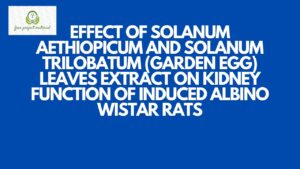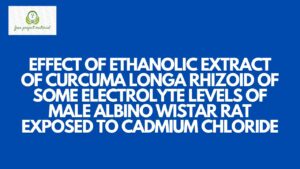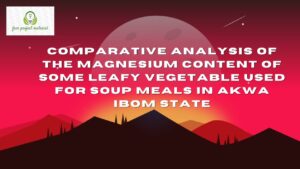ABSTRACT
The phytochemical screening of Portulaca oleracea leaf was carried out using standard analytical procedures. The result reveal that alkaloids and saponins were highly present, tannin, flavonoids and cardiac glycoside were tracely present. This may be the reason for the used of Portulaca oleracea leaf in herbal medicine. The result of the analysis is discussed.
TABLE OF CONTENTS
PAGE
TITLE PAGE- – – – – – – – i
CERTIFICATION- – – – – – – ii
DEDICATION- – – – – – – – iii
ACKNOWLEDGMENTS- – – – – – iv
ABSTRACT- – – – – – – – v
TABLE OF CONTENTS- – – – – – vi
CHAPTER ONE: INTRODUCTION
1.1 Background of the Study- – – – – – 1
1.2 Aim and Objectives of the study- – – – – 3
1.3 Scope and Limitation- – – – – – – 4
1.4 Significance of the Study- – – – – – 4
CHAPTER TWO: LITERATURE REVIEW
2.1 Description of Portulaca oleracea– – – – – 5
2.2 Wild Vegetable- – – – – – – – 6
2.3 Nutritional Value of Wild vegetables- – – – – 7
2.4 Health Benefits of Wild vegetables- – – – – 8
2.5 Phytochemicals Composition- – – – – – 8
2.5.1 Alkaloids- – – – – – – – – 8
2.5.2 Flavonoids- – – – – – – – – 10
2.5.3 Saponins- – – – – – – – – 10
2.5.4 Tannins- – – – – – – – – 12
2.5.5 Cardiac glycosides- – – – – – – 13
2.6 Functions of Phytochemicals- – – – – – 14
2.7 Phytochemicals Composition of other Wild Vegetables- – 15
CHAPTER THREE: MATERIALS AND METHODS
3.1 Materials and Methods- – – – – – – 18
3.2 Collection of Sample- – – – – – – 18
3.3. Extraction of Leaves Samples for Phytochemical
Analysis- – – – – – – – – 19
3.4 Determination of Phytochemical Analysis of the
Samples- – – – – – – – – 19
3.4.1 Determination of Alkaloids- – – – – – 19
3.4.2 Determination of Flavonoids- – – – – – 19
3.4.3 Determination of Saponins- – – – – – 20
3.4.4 Determination of Tannins- – – – – – 20
3.4.5 Determination of Cardiac glycosides- – – – – 20
CHAPTER FOUR: RESULTS AND DISCUSSION
4.1 Results- – – – – – – – – 22
4.2 Discussion- – – – – – – – – 23
CHAPTER FIVE: CONCLUSION AND RECOMMENDATION
5.1 Conclusion- – – – – – – – – 26
5.2 Recommendation- – – – – – – – 26
References
CHAPTER ONE: INTRODUCTION
1.1 Background of the Study
Portulaca oleracea are succulent annual, herbaceous plant belongs to the Portulacaceae family. It is commonly known as purslane in English (Eukhayat, 2008). It is distributed widely in the tropical and subtropical area of the world including many part of the United States and is eaten extensively as a potherb and is added to soups and salads around the mediteranean and tropical Asian countries (Palaniswamy, 2002). Portulaca oleracea provides rich sources of nutritional benefit owning to its rich omega-3 fatty acids and antioxidant properties (Palaniswamy, 2001). It grows well in vineyards, crop field, landscaped areas, garden and roadsides.
Portulaca oleracea has been used as a folk medicine in many countries, acting as febrifuge, antiseptic and vermifuge (Lee, 2012). Diverse compounds have been isolated from Portulaca oleracea, such as flavonoids, alkaloids, polysaccharides, fatty acids, terpenoids, sterols, proteins, vitamins and minerals. Portulaca oleracea possess a wide spectrum of pharmacological effect, including antibacterial (Zhang, 2002), anti-inflammatory (Chan, 2000), antioxidant (Chen, 2012) and wound heating properties.
The Chinese folk are described as “vegetable for long life” and it has been used for thousand of years in traditional Chinese medicine (Chen, 2009). It is cold in nature and sour in taste and is used to cool blood, bleeding, clear heat and resolve toxins. The dried part of this plant is indicated for the treatment of fever, dysentery, diarrhea and eczema with a recommended dose of 9-15g (Li et al., 2013).
Phytochemicals are chemicals compound produced by plant, generally help them resist, bacterial and plant virus, infections and also consumption by insects and other animals. Phytochemicals have been used as traditional medicine.
Phytochemicals compound are naturally occurring in medicinal plant parts such as leaves, stem leaf, fruits and roots. These compounds have the ability of defense mechanism against various disease-causing agent such as microbes and virus.
Phytochemicals are from Greek word “Phyto” meaning (“Plant”) are chemicals produced by plant through primary or secondary metabolism (Molynewt, 2007). The secondary metabolites are very good antioxidant compounds. They generally have biological activities in the plant host and play a role in plant growth or defense against competitors, pathogens or predator (Gardner, 2007). Phytochemical is generally used to describe plant compound that are under research with unestablished effect on health and are not scientifically defined as essential nutrient.
1.2 Aim and Objectives of the Study
The aim of this study was to investigate the phytochemical constituent of the leaf of Portulaca oleracea.
The Objectives of this Study were:
- To determine the alkaloids Concentration
- To determine the flavonoids Concentration
- To determine the saponins Concentration
- To determine the tannins Concentration
- To determine the cardiac glycoside Concentration
1.3 Scope and Limitation
The scope of this study only focused on the phytochemical screening of Portulaca oleracea.
Limitation
This study was limited by time, financial constraints and the level of study.
1.4 Significance of the Study
This work will be of immense important to student and researchers as references purpose.



